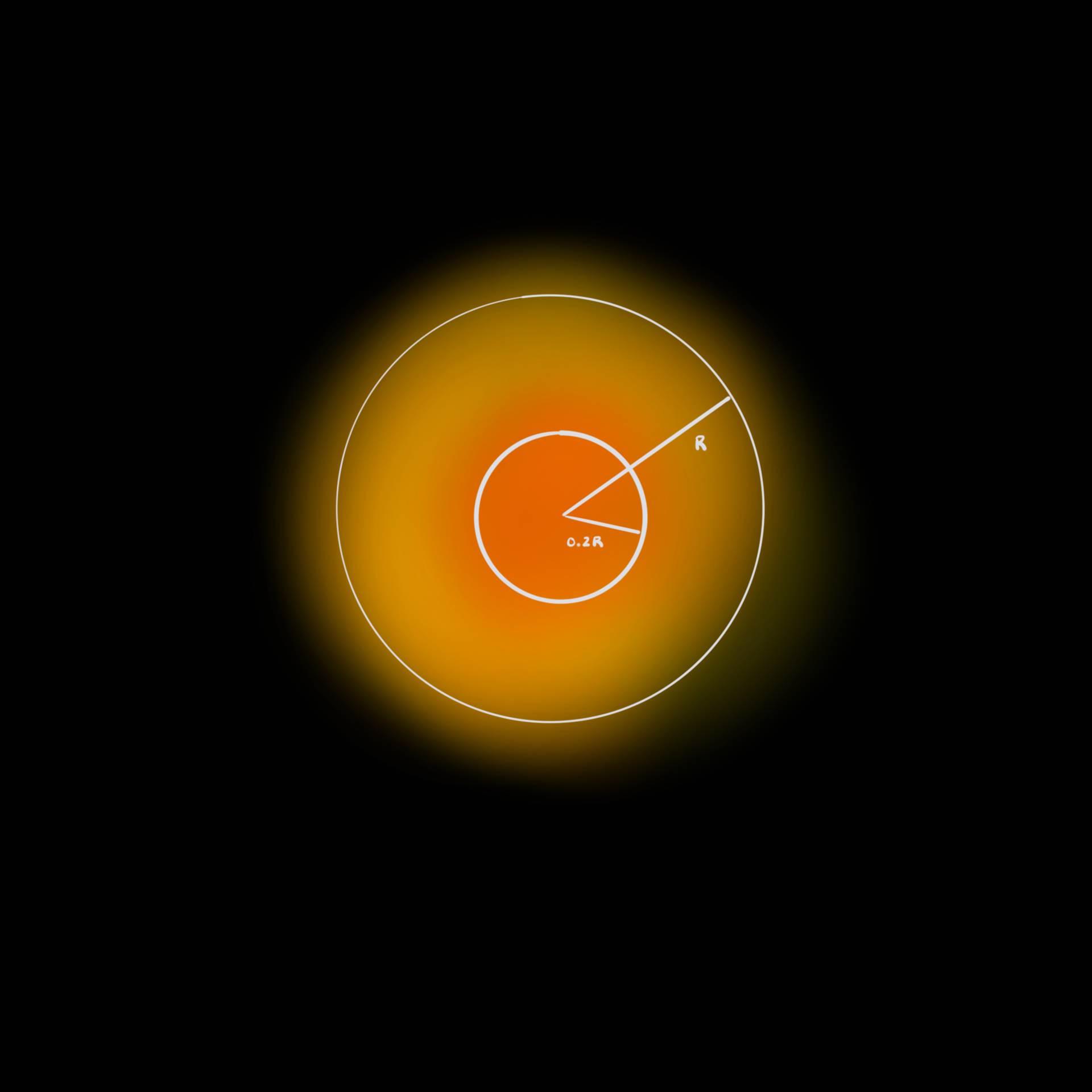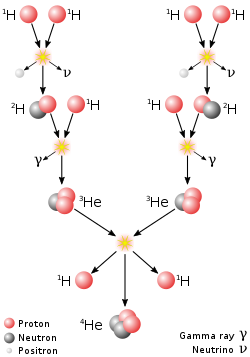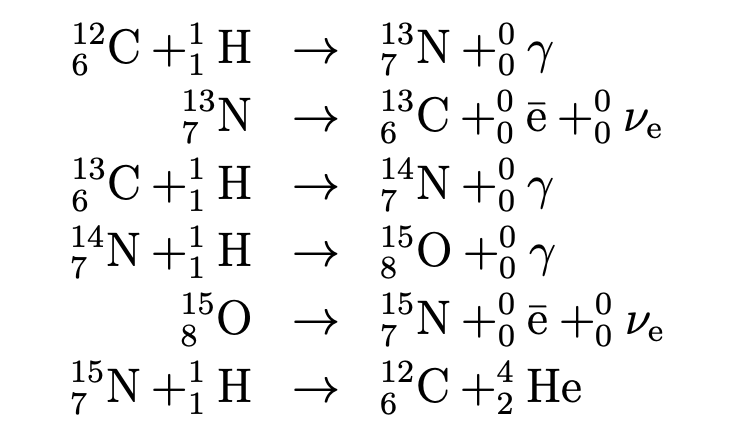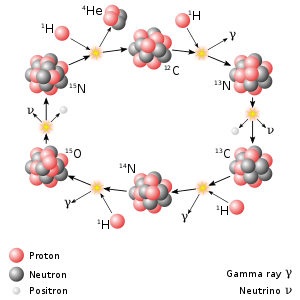We are simply entering a game of "Hot and Cold" except for that we are moving towards the core of Calcifer and it is getting WAY TOO FUCKING HOT! but how hot of a core temperature are we talking about?
Assumptions to be made and their corresponding equation:
-
Uniform star density meaning the density is the same everywhere within the star and does not vary with distance from star center: \(\rho(r) = \rho\)
-
The pressure inside Calcifer with the gaseous pressure of an ideal gas: \(P(r) = \frac{\rho(r)kT(r)}{\mu m_H}\)
-
Interior of Calcifer is in hydrostatic equilibrium: \(\frac{dP}{dr} = -\rho(r)g(r)\)
-
Calcifer consist entirely of protons with mass \(m_H = 1.673\cdot 10^{-27} kg\)
-
That I slept more than 4 hours tonight
Concepts and equations can be found in "An atmosphere walks into a bar..." (deduced there as well)
\( \text{ Gravitational acceleration: }g(r) = G\frac{M(r)}{r^2}\) from Newtons second law of motion. G is gravitational constant 6.67*10-11 \(\frac{N\cdot m^2}{kg^2}\).
Values written as a function of r (eks. T, \(\rho\), g) are dependent on distance r from star center we are looking at. Not to be confused with R which will be introduced later.
Here is the step-by-step instruction on how we are going to find the core temperature of Calcifer.
1. Derive an expression for the spherical mass profile of Calcifer
We know for a fact that the star density is uniform. Density is mass per volume, meaning if you chopped up Calcifer into dices, the mass of that dice would be the density. Since the density is uniform, all dices will have equal weight.
The reason we decided to have this as a first step will become more clear further down.
\(M(r) = \frac{\rho(r)}{v}= \rho\frac{4}{3}\pi r^3\)
2. Combine relevant assumptions
If you take at a look at the list of assumptions, you might notice that the equation for hydrostatic equilibrium includes equations for pressure and gravitational acceleration. So it will only make sense to combine them. We'll begin with the equation for hydrostatic equilibrium:
\(\frac{dP}{dr} = -\rho(r)g(r)\)
Insert \(P(r) = \frac{\rho(r)kT(r)}{\mu m_H}\) and \(g(r) = G\frac{M(r)}{r^2}\)
\(\frac{d}{dr} \frac{\rho k T(r)}{\mu m_H} = -\rho G\frac{M(r)}{r^2}\)
Here comes the reason for why we found the spherical mass profile of Calcifer first. It became useful for us here! The only mysterious variable is in fact the mass.
Insert \(M(r) = \rho\frac{4}{3}\pi r^3\)
\(\frac{d}{dr}T(r) = -\rho G\frac{4}{3}\pi r^3\rho \frac{\mu m_H}{\rho k r^2} \)
Clean up a little bit.
\(\frac{d}{dr} T(r) = -\frac{4\pi}{3}G\rho\frac{\mu m_H}{k}r\)
3. Integrate from r = 0 to r = R, where r = 0 is the core and r = R is star surface/ star radius
Tc = T(0) is our star's core temperature
\(\int_{0}^{R} T(r) = \int_{0}^{R}-\frac{4\pi}{3}G\rho\frac{\mu m_H}{k}r dr\)
\(\int_{0}^{R} T(r) = -\frac{4\pi}{3}G\rho\frac{\mu m_H}{k}\int_{0}^{R}r dr\)
\(T(R) - T(c) = -\frac{2\pi}{3}G\rho\frac{\mu m_H}{k} R^2\)
\(T(c) = T(R) + \frac{2\pi}{3}G\rho\frac{\mu m_H}{k} R^2\)
We found an expression for core temperature! It is dependent on surface temperature and star radius among other things. Estimated core temperature of Calcifer is therefore:
Core temperature of Calcifer: 19879241.876611616 K
Core temperature of Calcifer is approximately 19.8*106 K, which is like 19878968.72 degrees celcius.
Realistic? I expected a numbers of magnitude 106/ 1 million based on the core temperature of the sun. Since that was fulfilled, I am pretty satisfied then.
Are we finished? NO! :)
We found the core temperature, might as well use this to estimate the luminosity of Calcifer.
Karl: We already did that?
Rebecca: Yes :) but not based on nuclear reactions in its core. Everything is about them core muscles baby.

All nuclear reactions happen within a radius of 0.2R (R is star radius). We found a luminosity Tc < 90*106 K, which hands us these assumptions to be made about the nuclear core reactions in Calcifer.
Assumptions:
- Energy production in core occurs via. the pp-chain and CNO-cycle (explained further down)
- Core consist of 74.5% Hydrogen, 25.3% Helium and 0.2% Carbon, Oxygen and Nitrogen
- Uniform star density meaning the density is the same everywhere within the star and does not vary with distance from star center: \(\rho(r) = \rho\)
- The core temperature calculated above is the same throughout the core.
- That I have not forgotten to eat dinner.
Here is a brief introduction to fusion reactions in Calcifer's core
PP- CHAIN (proton-proton chain)
2 Hydrogen atoms are converted to 1 Helium atom. It looks something like this written out


It also like this illustrated.
This is one of the most important chain reaction in solar core. There are also other versions of pp-chain. This is most effective for temperature around 15 million Kelvin, which is perfect since Calcifer is around 19 million Kelvin.
The full chain reaction can also be written as
\(\epsilon_{pp} \approx \epsilon_{0, pp} X_H^2\rho T_6^4\)
\(\epsilon\): Energy radiated per mass over time
where:
\(\epsilon_{0, pp} = 1.08 \cdot 10^{-12} \frac{Wm^3}{kg^2} \text{ (given value)}\)
\(T_6 = \text{ Temperature in 1 million Kelvin. } T_6 = 15 \rightarrow T = 1\cdot 10^6 C\)
\(X_H = \text{ Fraction of mass which consist of Hydrogen. In our case it is given as 74.5%.}\)
CNO-CYCLE (Carbon-Nitrogen-Oxygen cycle)
In this chain reaction four Hydrogen atoms are converted to a Helium atom.


Total reaction rate:
\(\epsilon_{CNO}\approx \epsilon_{0, CNO}X_HX_{CNO}\rho T_6^{20}\)
where:
\(\epsilon_{0, CNO} = 8.24\cdot 10^{-31} \frac{Wm^3}{kg^2}\)
\(X_{CNO} =\text{ 0.2% }\)
The connection between mass, luminosity and energy production from nuclear core reactions is given as
\(\epsilon = \frac{dL}{dm}= \frac{dL(r)}{v\rho}= \frac{dL(r)}{4\pi r^2 \cdot dr \cdot\rho(r)}\)
Energy production occurs via pp-chain and CNO-chain, making the total energy production \(\epsilon = \epsilon_{0, pp} + \epsilon_{0, CNO}\)
From which we obtain this expression for core luminosity
\(\frac{dL(r)}{dr} = 4\pi r^2 \rho (\epsilon_{0, pp} + \epsilon_{0, CNO})\)
As we did earlier, we'll integrate from center of Calcifer to 0.2R. Basically, where these fusions happen
\(\int_{0}^{0.2R} dL(r) =\int_{0}^{0.2R} 4\pi r^2 \rho (\epsilon_{0, pp} + \epsilon_{0, CNO}) dr\)
\(L(0.2R) = 4\pi \rho (\epsilon_{0, pp} + \epsilon_{0, CNO}) \frac{(0.2R)^3}{3}\)
Which gives us a luminosity of
Calcifer's luminosity based on nuclear core reactions: 6.518903878824093e+24 W
Uhm?
So using Stefan-Boltzmann law the luminosity of Calcifer is 9.179*1025 W, but based on nuclear core reactions it is 6.519*1024 W?
What went wrong?
I believe our list of assumptions are the culprit. Here is the thing, when you assume things, you either exclude information or simplify equation. In our case, I don't believe the core temperature is the same throughout the core. Nuclear chain reactions are highly sensitive. Take a look at the reaction rate for CNO cycle, T620!! A subtle change in temperature will give a completely different result due to 20 in the exponent. Temperature is a sensitive bitch.
The source of error could also have begun when calculating the core temperature. Star cannot be so perfect that we have the same density EVERYWHERE within the star and ideal gas, which conveniently hands us these equations which are easy to solve.
We also assumed that Calcifer consist of ONLY Hydrogen because they are quite easy to work with.
Moral of the story: Tinder dates are not the perfect love story you would have imagined. You got to know Calcifer. His luminosity (two ways), core temperature, childhood and more. You realised you made way too many assumptions before the date and found out he is not perfect. However, you still love him <3
